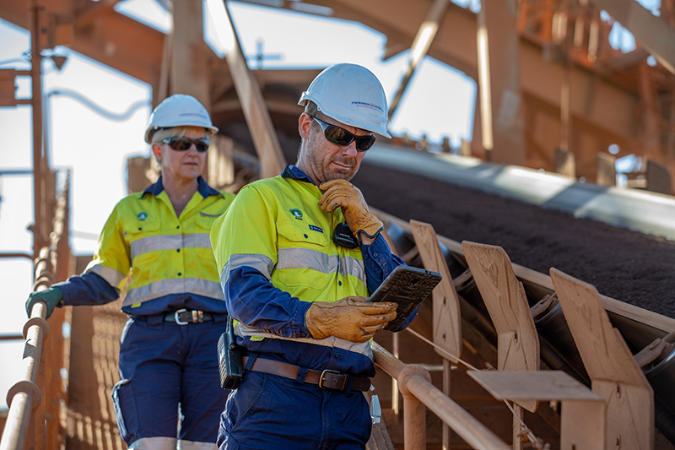Mapping the Future of Intelligent Conveying
Article published in the Australian Mining.
Fenner Dunlop’s iBelt intelligent conveyor technology is delivering more efficient minerals processing applications through a suite of smart solutions.
Australia is home to some of the largest mining operations globally, delivering highly sought-after commodities to major markets.
Data from the Australian Bureau of Statistics shows that iron ore, gold and copper achieved record high exports in 2020, with the resources sector contributing $270 billion to the nation’s economy last year.
To keep operations moving, mining companies are required to invest in robust minerals processing infrastructure to handle and refine ore and prepare it for shipment.
With thousands of tonnes of materials processed at mining operations each day, the conveyor belt remains a crucial element of this process.
Its reliability is vital to avoid unplanned downtime at a mine site as the price of a conveyor belt replacement can put a significant dent in capital costs and productivity.
The evolution of heavy industry technologies through sensors and remote operations has opened the door for mining companies to enhance the monitoring and predictive maintenance of their plant and equipment through new technologies.
Fenner Dunlop is at the forefront of delivering technologies to digitalise and automate conveyor maintenance processes and enhance the performance of sites.
The company’s iBelt intelligent conveyor solution is increasing productivity and giving customers real-time transparency of their plant’s performance with predictive analytics and other insights.
Being called to action immediately when an issue is identified and having the tools to continually improve reliability, the result for customers is getting more out of their conveyors, with less and with ease.

iBelt comprises five intelligent products – BeltGauge, BeltTag, CordScan, RipSaver and DigitalHub.
“Our vision for these products is to make conveyors intelligent, where they predict, analyse and learn autonomously almost as if they have an actual brain,” Fenner Dunlop general manager for conveyor technology Craig Philpotts tells Australian Mining.
“iBelt solutions take people out of the firing line of conveyor hazards and allow them to gather and analyse data over the cloud.
“Traditionally, they would have to go and walk the conveyors on site. Now our products provide the information at their fingertips.”
By digitising conveyor maintenance and condition monitoring, data can be obtained in real time to prevent issues from arising over the lifecycle of the system.
With hard border closures becoming a challenge for the mining industry, this technology also allows operators to monitor conveyor performance even when they are off site.
“Given that the analysis is done autonomously and on the conveyor itself, data is continually sent to the cloud and portrayed back to the client in a usable format – whether or not that may be in the form of interactive charts or filterable list, screens are designed to communicate important information and trends easily to customers,” Philpotts says.
Fenner Dunlop launched iBelt last year and has since grown the solution beyond the belt itself by implementing digital inspections and idler management across the entire conveyor system to help customers save costs.
“There are many components on a conveyor system other than just the belt and they all influence each other. For example, a skirt system can have a significant impact to the belt’s life if not properly monitored and maintained. With our new mobile app, we can really ensure there is transparency across the whole conveyor,” Philpotts says.
Another new development for iBelt is the mobile BeltGauge solution, which is lighter and more productive than the previous unit. It provides the same benefits as the fixed unit with full length profiling of the belt and being able to perform thickness testing without stopping the belt, but gives the customer flexibility in choice and frequency, particularly on less critical systems.
BeltGauge enables a greater understanding of how the belt interacts with other components on the conveyor and this depth of analysis is one that Fenner Dunlop is spearheading in the industry.
“Where we’re heading now is very much around using the data collected to improve not only the lifecycle of the current conveyor components, but analyse the types of compounds that are actually used in the manufacture of conveyor belt to design compounds that last longer,” Philpotts says.
“This data is invaluable to sites to make sure they get the most out of their conveyors and have accurate predictions of when they need to be changed out.”
Fenner Dunlop’s commitment to its iBelt intelligent conveying vision also includes a new technology team dedicated to developing and expanding its digital product and service offerings here in Australia.
The launch of iBelt last year marked the early steps of a new journey for Fenner Dunlop over the next decade, where it hopes to continue to offer solutions that embrace the benefits of digitising mine sites.
“We recognise the importance of digitisation and product development in our industry and is one of four key strategies for Fenner over the next 10 years. We are confident our efforts in product development align with our customers’ needs and aim to be at the forefront of development of any mine site in Australia and the world,” Philpotts concludes.